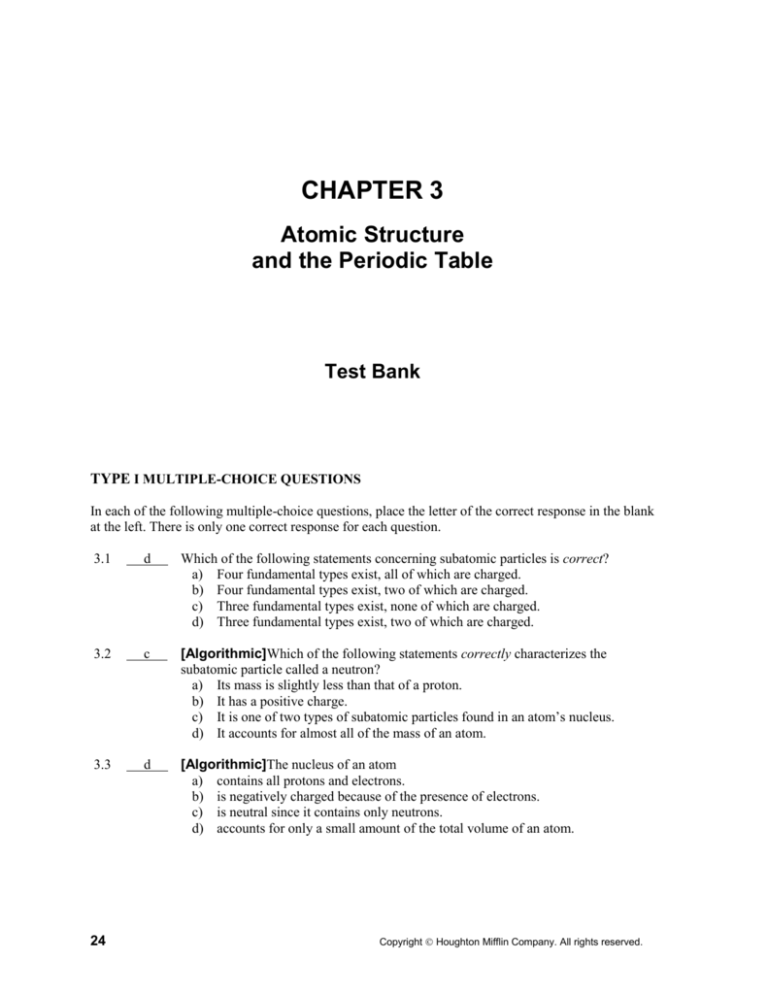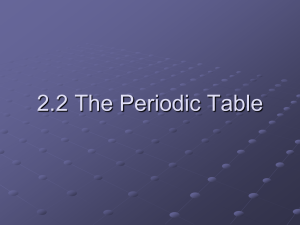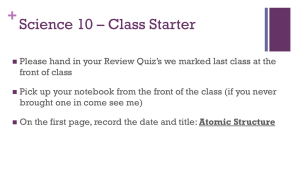
CHAPTER 3
Atomic Structure
and the Periodic Table
Test Bank
TYPE I MULTIPLE-CHOICE QUESTIONS
In each of the following multiple-choice questions, place the letter of the correct response in the blank
at the left. There is only one correct response for each question.
3.1
d
Which of the following statements concerning subatomic particles is correct?
a) Four fundamental types exist, all of which are charged.
b) Four fundamental types exist, two of which are charged.
c) Three fundamental types exist, none of which are charged.
d) Three fundamental types exist, two of which are charged.
3.2
c
[Algorithmic]Which of the following statements correctly characterizes the
subatomic particle called a neutron?
a) Its mass is slightly less than that of a proton.
b) It has a positive charge.
c) It is one of two types of subatomic particles found in an atom’s nucleus.
d) It accounts for almost all of the mass of an atom.
3.3
d
[Algorithmic]The nucleus of an atom
a) contains all protons and electrons.
b) is negatively charged because of the presence of electrons.
c) is neutral since it contains only neutrons.
d) accounts for only a small amount of the total volume of an atom.
24
Copyright Houghton Mifflin Company. All rights reserved.
Test Bank
Chapter 3: Atomic Structure and the Periodic Table
Copyright Houghton Mifflin Company. All rights reserved.
25
26
Chapter 3: Atomic Structure and the Periodic Table
Test Bank
3.4
c
Atoms are neutral because
a) all atoms contain neutrons.
b) all subatomic particles lose their charges once they enter an atom.
c) equal numbers of protons and electrons are present.
d) the number of subatomic particles in the nucleus is always an even number.
3.5
c
3.6
a
[Algorithmic]An atom contains 26 protons, 30 neutrons and 26 electrons. The
atomic number and mass number for this atom are, respectively,
a) 30 and 26.
b) 26 and 30.
c) 26 and 56.
d) 30 and 56.
27
Si?
[Algorithmic]Which of the following statements is correct for 14
a) contains more protons than neutrons
b) contains more electrons than protons
c) contains an equal number of protons and neutrons
d) contains more neutrons than electrons
3.7
d
[Algorithmic]The quantity “A + Z” gives the number of
a) protons in an atom.
b) neutrons in an atomic nucleus.
c) nucleons in an atom.
d) subatomic particles in an atom.
3.8
b
Isotopes of a given element
a) have the same mass number but different numbers of protons.
b) have different mass numbers but identical numbers of protons.
c) have the same atomic number but different chemical properties.
d) have the same mass number but different chemical properties.
3.9
d
[Algorithmic]Chlorine, which exists in nature in two isotopic forms, has an atomic
mass of 35.5 amu. This means that
a) all chlorine atoms have masses of 35.5 amu.
b) some, but not all, chlorine atoms have masses of 35.5 amu.
c) 35.5 amu is the upper limit for the mass of a chlorine atom.
d) no chlorine atoms have masses of 35.5 amu.
3.10
c
[Algorithmic]Two naturally occurring isotopes exist for the hypothetical element
dippium. 30.0% of dippium atoms have a relative mass of 6.0 amu and 70.0% a
relative mass of 8.0 amu. What is the atomic mass of dippium?
a) 6.8 amu
b) 7.2 amu
c) 7.4 amu
d) 14.0 amu
Copyright Houghton Mifflin Company. All rights reserved.
Test Bank
Chapter 3: Atomic Structure and the Periodic Table
27
3.11
d
The modern periodic table arranges the elements in order of
a) year of discovery.
b) decreasing size of the nucleus.
c) increasing reactivity with oxygen.
d) increasing number of protons.
3.12
c
[Algorithmic]In which of the following pairs of elements are both members of the
pair in the same period in the periodic table?
a) 10Ne and 11Na
b) 24Cr and 42Mo
c) 19K and 33As
d) 1H and 3Li
3.13
d
[Algorithmic]In which of the following pairs of elements are both members of the
pair metals?
a) 15P and 34S
b) 31Ga and 35Br
c) 40Zr and 86Rn
d) 48Cd and 50Sn
3.14
c
The correct electron configuration for 17Cl is
a) 1s22s22p5.
b) 1s22s22p63s2.
c) 1s22s22p63s23p5.
d) 1s22s22p63s23p64s23d5.
3.15
b
[Algorithmic]Which of the following statements is consistent with the electron
configuration 1s22s22p63s23p6?
a) There are 6 electrons present in a 3p orbital.
b) There are 6 electrons present in a 3p subshell.
c) There are 6 electrons present in a 3p shell.
d) There are 6 electrons present in the third shell.
3.16
a
[Algorithmic]After the 5s subshell of an atom is filled with electrons, the next
electron added will enter the
a) 4d subshell.
b) 5p subshell.
c) 5d subshell.
d) 6s subshell.
3.17
c
How many unpaired electrons are present in the orbital diagram for an atom whose
electron configuration is 1s22s22p4?
a) 0
b) 1
c) 2
d) 4
Copyright Houghton Mifflin Company. All rights reserved.
28
Chapter 3: Atomic Structure and the Periodic Table
Test Bank
3.18
a
[Algorithmic]Which of the following statements about a d subshell is correct?
a) It contains 5 orbitals.
b) It may contain a maximum of 14 electrons.
c) It is found only in shells 4 and 5.
d) It is found in all shells.
3.19
a
The elements in group IVA of the periodic table all have electron configurations
ending in
a) p2.
b) p4.
c) d4.
d) s2.
3.20
d
[Algorithmic]Which of the following element-classification pairings is incorrect?
a) 7N S representative element
b) 18Ar S noble gas element
c) 26Fe S transition element
d) 74Re S inner-transition element
TYPE II MULTIPLE-CHOICE QUESTIONS
In each of the following multiple-choice questions, place the letter of the correct response in the blank
at the left. There may be more than one correct response for a question (choice d) or no correct
response for a question (choice e).
3.21
e
Which of the following statements correctly describes the subatomic particle called a
neutron?
a) has a mass slightly less than that of a proton
b) is not found in the nucleus
c) has a positive charge
d) more than one correct response
e) no correct response
3.22
d
Which of the following statements concerning the nucleus of an atom is correct?
a) It accounts for almost all of the mass of an atom.
b) It is always positively charged.
c) It contains only neutrons.
d) more than one correct response
e) no correct response
3.23
b
Which of the following collections of subatomic particles possesses a net charge of
+2?
a) two neutrons and two electrons
b) three protons and one electron
c) three electrons and one proton
d) more than one correct response
e) no correct response
Copyright Houghton Mifflin Company. All rights reserved.
Test Bank
Chapter 3: Atomic Structure and the Periodic Table
29
27
Si?
Which of the following statements is correct for 14
a) atomic number = 27 and mass number = 14
b) contains 14 protons and 27 neutrons
c) contains an equal number of protons and electrons
d) more than one correct response
e) no correct response
3.24
c
3.25
a
Tin is element number 50. This means that all tin atoms have
a) an atomic number of 50.
b) 50 neutrons in the nucleus.
c) a total of 50 subatomic particles in the nucleus.
d) more than one correct response
e) no correct response
3.26
b
Which of the following pairs of atoms, specified in terms of subatomic particle
composition, are isotopes?
a) (24p, 24e, 24n) and (25p, 25e, 25n)
b) (24p, 24e, 24n) and (24p, 24e, 28n)
c) (24p, 24e, 28n) and (25p, 25e, 28n)
d) more than one correct response
e) no correct response
3.27
e
Element A exists in three isotopic forms with masses of 21.0, 25.0 and 26.0 amu,
respectively. Element Q also exists in three isotopic forms with masses of 23.0, 24.0
and 25.0 amu, respectively. It is true that
a) element A has a lower atomic mass than element Q since it has the lightest
isotope.
b) elements A and Q have identical atomic masses since the sums of their isotopic
masses are equal.
c) element Q has a higher atomic mass than element A since its atomic masses
are closer together.
d) more than one correct response
e) no correct response
3.28
d
Period number and group number in the periodic table are numerically equal for
which of the following elements?
a) 13Al
b) 33As
c) 51Sb
d) more than one correct response
e) no correct response
3.29
c
Which of the following periodic table groups contains three or more nonmetallic
elements?
a) IIIA
b) IVA
c) VA
d) more than one correct response
e) no correct response
Copyright Houghton Mifflin Company. All rights reserved.
30
Chapter 3: Atomic Structure and the Periodic Table
Test Bank
3.30
d
Both a number and a letter are used in designating an electron subshell. The letter
a) indicates the shell to which the subshell belongs.
b) may be s, p, d, or f.
c) gives information about the maximum number of electrons the subshell can
contain.
d) more than one correct response
e) no correct response
3.31
e
Which of the following electron configurations corresponds to an element in the
same group of the periodic table as the element whose electron configuration is
1s22s22p5?
a) 1s22s22p4
b) 1s22s22p6
c) 1s22s22p63s23p64s23d5
d) more than one correct response
e) no correct response
3.32
a
Two unpaired electrons are present in the orbital diagram of which of the following
elements?
a) 6C
b) 10Ne
c) 12Mg
d) more than one correct response
e) no correct response
3.33
d
Which of the following characterizations for the element 23V is correct?
a) a period 4 element
b) electron configuration ends in d3
c) an inner-transition element
d) more than one correct response
e) no correct response
3.34
c
Which of the following characterizations for the element 52Te is correct?
a) both a representative element and a metal
b) electron configuration involves a partially filled s subshell
c) electron configuration involves a total of 52 electrons
d) more than one correct response
e) no correct response
3.35
e
Which of the following statements concerning types of elements is correct?
a) There are more noble gas elements than transition elements.
b) There are more s-block elements than d-block elements.
c) There are more nonmetals than metals.
d) more than one correct response
e) no correct response
Copyright Houghton Mifflin Company. All rights reserved.
Test Bank
Chapter 3: Atomic Structure and the Periodic Table
31
MULTIPLE-CHOICE FORMAT TRUE-FALSE QUESTIONS
In each of the following multiple-choice questions, characterize EACH of the three given statements
as being TRUE or FALSE and then indicate the collective true-false status of the statements using the
choices
a) All three statements are true.
b) Two of the three statements are true.
c) Only one of the statements is true.
d) None of the statements is true.
3.36 d - FFF
Statements:
(1) The number of elements that are metals and nonmetals is approximately equal.
(2) The number of orbitals present in an electron subshell is always six.
(3) An atom as a whole is electrically neutral because all charged subatomic
particles reside in the nucleus.
a) All three statements are true.
b) Two of the three statements are true.
c) Only one of the statements is true.
d) None of the statements is true.
3.37 c - TFF
Statements:
(1) The shape of an s orbital is always spherical.
(2) All naturally occurring atoms of an element must be identical to each other in
terms of subatomic particle makeup.
(3) The alkaline earth metals are the elements in group IA of the periodic table.
a) All three statements are true.
b) Two of the three statements are true.
c) Only one of the statements is true.
d) None of the statements is true.
3.38 b - TTF
Statements:
(1) The mass of an atom and the mass of its nucleus are essentially the same.
(2) Two of the six electrons present in an atom of carbon are unpaired.
(3) The element aluminum is located in the d area of the periodic table.
a) All three statements are true.
b) Two of the three statements are true.
c) Only one of the statements is true.
d) None of the statements is true.
Copyright Houghton Mifflin Company. All rights reserved.
32
Chapter 3: Atomic Structure and the Periodic Table
3.39 a - TTT
Test Bank
Statements:
(1) The sum of the mass number and the atomic number for an atom corresponds
to the total number of subatomic particles present in the atom.
(2) The element sulfur is both a nonmetal and a representative element.
(3) Elements with electron configurations that end in p4 would be found in group
VIA of the periodic table.
a) All three statements are true.
b) Two of the three statements are true.
c) Only one of the statements is true.
d) None of the statements is true.
3.40 b - TTF
Statements:
(1) Electrons occupy the orbitals of a subshell such that each orbital acquires one
electron before any orbital acquires a second electron.
(2) The nucleus of an atom is always positively charged.
(3) Both electrons and protons are massive particles when compared with
neutrons.
a) All three statements are true.
b) Two of the three statements are true.
c) Only one of the statements is true.
d) None of the statements is true.
3.41 d - FFF
Statements:
(1) The maximum number of electrons that can occupy an electron shell is the
same as the shell number.
(2) A nucleus is the very small dense uncharged center of an atom.
(3) The number of inner transition elements is greater than the number of
transition elements.
a) All three statements are true.
b) Two of the three statements are true.
c) Only one of the statements is true.
d) None of the statements is true.
3.42 c - TFF
Statements:
(1) Most of the mass of an atom is concentrated in its nucleus.
(2) Sufficient information is present on a “standard” periodic table to determine
the number of neutrons present in atoms of an element.
(3) An atom whose electron configuration is 1s22s22p63s1 contains twelve
electrons.
a) All three statements are true.
b) Two of the three statements are true.
c) Only one of the statements is true.
d) None of the statements is true.
Copyright Houghton Mifflin Company. All rights reserved.
Test Bank
3.43 b - FTT
Chapter 3: Atomic Structure and the Periodic Table
33
Statements:
(1) All naturally occurring atoms of an element must have the same mass number.
(2) Protons and electrons carry the same amount of charge.
(3) An isotope of chlorine with A = 35 and Z = 17 contains more neutrons than
protons.
a) All three statements are true.
b) Two of the three statements are true.
c) Only one of the statements is true.
d) None of the statements is true.
3.44 c - TFF
Statements:
(1) An electron configuration specifies subshell occupancy for electrons.
(2) The atomic number is double the mass number for atoms that contain an equal
number of protons and neutrons.
(3) All occupied orbitals are completely filled in atoms of the element neon, which
contains a total of 12 electrons.
a) All three statements are true.
b) Two of the three statements are true.
c) Only one of the statements is true.
d) None of the statements is true.
3.45 b - TTF
Statements:
(1) An atom is in an excited state when one or more of its electrons is in higher
energy, normally unoccupied orbitals.
(2) Most, but not all, of the trace elements needed for the proper functioning of the
human body are metals.
(3) Deuterium is an isotope of hydrogen in which two protons are present.
a) All three statements are true.
b) Two of the three statements are true.
c) Only one of the statements is true.
d) None of the statements is true.
MATCHING QUESTIONS
For each characterization on the left, choose the correct atom from the response list on the right.
Responses on the right may be used more than once or need not be used at all.
3.46
d
Has an atomic number of 17
a)
25
12 Mg
3.47
c
Has a mass number of 17
b)
40
20 Ca
3.48
d
Has a nuclear charge of +17
c)
17
9F
3.49
b
Has an equal number of protons, neutrons, and electrons
d)
37
17 Cl
3.50
c
Has fewer neutrons than electrons
Copyright Houghton Mifflin Company. All rights reserved.
34
Chapter 3: Atomic Structure and the Periodic Table
Test Bank
For each characterization on the left, choose an appropriate pair of atoms from the response list on the
right. Responses on the right may be used more than once or need not be used at all.
Copyright Houghton Mifflin Company. All rights reserved.
Test Bank
3.51
d
Chapter 3: Atomic Structure and the Periodic Table
Atoms that contain the same number of protons
a)
b)
3.52
d
Atoms that contain the same number of electrons
c)
d)
3.53
c
Atoms that contain the same number of neutrons
3.54
a
Atoms that contain the same number of nucleons
3.55
b
Atoms that contain the same number of subatomic
particles
Copyright Houghton Mifflin Company. All rights reserved.
13
13
6 C and 7 N
37
36
17 Cl and 18 Ar
18
19
8 O and 9 F
6
7
3 Li and 3 Li
35
For each characterization on the left, choose an appropriate electron configuration from the response
list on the right. Responses on the right may be used more than once or need not be used at all.
3.56
a
Element that has five completely filled
subshells
3.57
b
Element whose third shell contains six
electrons
3.58
c
Element that has electrons in six orbitals
3.59
b
Element that has two unpaired electrons
3.60
a
Element with no unpaired electrons
a)
b)
c)
d)
1s22s22p63s23p6
1s22s22p63s23p4
1s22s22p63s1
1s22s22p5
For each characterization on the left, choose an appropriate pair of elements from the response list on
the right. Responses on the right may be used more than once or need not be used at all.
3.61
a
Elements are in the same period of the
periodic table.
a)
37Rb
and 38Sr
3.62
c
Elements are in the same group of the
periodic table.
c) 9F and 17Cl
d)
b) 7N and 82Pb
3.63
c
Elements have similar chemical properties.
3.64
d
Elements are in the d area of the periodic
table.
3.65
c
Elements have electron configurations ending
in p5.
42Mo
and 75Re
40
Chapter 3: Atomic Structure and the Periodic Table
Test Bank
Copyright Houghton Mifflin Company. All rights reserved.
For each characterization on the left, choose an appropriate element from the response list on the
right. Responses on the right may be used more than once or need not be used at all.
3.66
c
A transition element
3.67
d
An inner-transition element
3.68
a
A halogen
3.69
b
Both a metal and a representative element
3.70
a
Both a nonmetal and a representative element
a) 9F
b) 50Sn
c) 79Au
d)
92U










